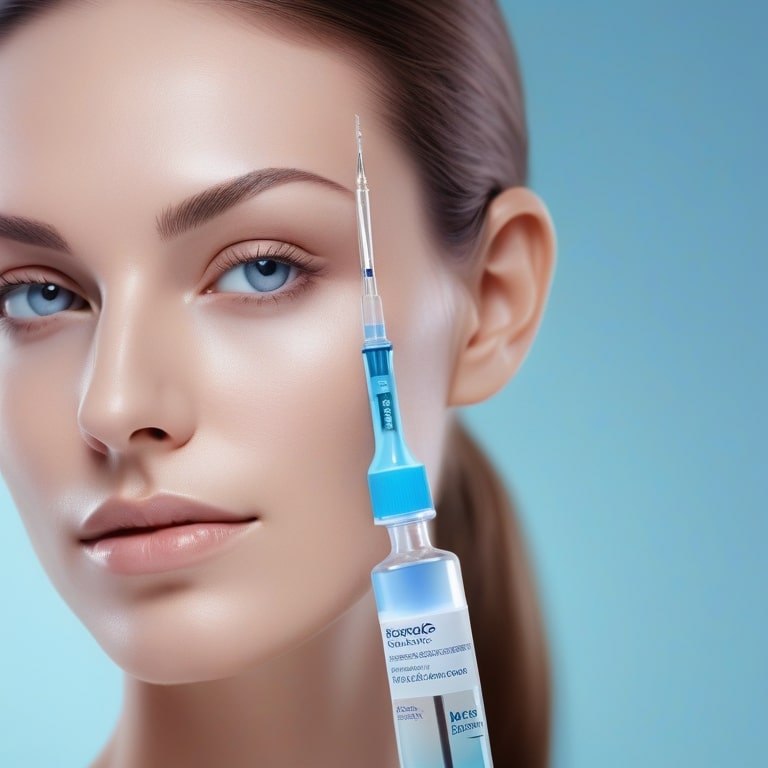Is Dysport Safer Than Botox? A Comprehensive Safety Comparison

When you think about cosmetic treatment, botulinum toxin injections like Dysport and Botox are very popular for reducing wrinkles. However, since both options are similar, it can be hard to choose which one is safer. This comparison will clearly explain the differences between Dysport and Botox for cosmetic purposes. It will also look at the side effects of each to help you decide.
Each treatment uses the same active ingredient, botulinum toxin type A, but the formulations and their effects can differ. Botox has been on the market longer and is more widely recognized, while Dysport may offer quicker results in some cases. When asking, “Is Dysport safer than Botox?” it’s crucial to consider factors such as dosage, spread, onset of results, and potential side effects. Both treatments are generally safe when administered by experienced professionals, but understanding the nuances can help you make a well-informed decision about the right option for your cosmetic goals.
Understanding Dysport and Botox
Dysport and Botox are both types of medications that doctors inject into certain facial muscles. These injections help by blocking nerve signals. This stops muscle contractions, making the skin look smoother. Both Dysport and Botox use botulinum toxin type A as the main active ingredient.
Though they work in a similar way, there are small differences between them. Dysport is approved by the FDA for treating moderate to severe glabellar lines. These are the vertical lines that show up between the eyebrows, often called “11” lines. Botox is also approved for glabellar lines. But Botox can treat forehead lines and crow’s feet too.
Key Highlights
- Dysport and Botox are both botulinum toxin type A injectables that temporarily reduce the appearance of wrinkles.
- Dysport is FDA-approved for moderate to severe glabellar lines, while Botox is approved for glabellar lines, forehead lines, and crow’s feet.
- Both injectables work by blocking nerve signals, which in turn relaxes muscle contractions and diminishes the appearance of wrinkles.
- Dysport and Botox have similar safety profiles, with minor side effects like bruising at the injection site.
- A consultation with a board-certified professional like those at Total Anti-Aging and Wellness is recommended to determine the best option for you.
The science behind Dysport: How it works
Dysport injections focus on the muscles that cause wrinkles. The main ingredient is a type of botulinum toxin. It stops the nerve signals that tell these muscles to contract.
When the muscles do not contract, the skin over them is no longer pulled or creased. This helps to create a smoother and more youthful look. Basically, Dysport relaxes the active muscles that cause wrinkles.
By reducing muscle activity, Dysport can soften existing wrinkles. It may also help stop new wrinkles from forming. These injections are precise and target specific areas where wrinkles are the worst.
The science behind Botox: How it works
Similar to Dysport, Botox injections use botulinum toxin from the Clostridium botulinum bacteria. They focus on certain facial muscles. Once Botox is injected, it stops nerve signals from the brain to these muscles.
This stop in nerve signals weakens the muscle. As a result, the muscle cannot contract. When facial muscles contract, they cause lines and wrinkles in the skin above. By decreasing the muscle activity with Botox injections, the appearance of these wrinkles gets better.
Botox is injected just into the muscles that cause wrinkles. So, the effects mostly stay in the treatment area. With regular Botox treatments, the muscles can be trained to push less hard. This means there can be a more lasting decrease in the appearance of wrinkles.
Analyzing the Safety Profile
Both Dysport and Botox are known for being safe when given by a qualified doctor. These treatments have been carefully studied and are approved by the FDA, which shows they are generally safe for cosmetic use.
People often worry about safety when thinking about injections. However, if a trained professional does the treatment right, Dysport and Botox are safe choices. They help reduce the appearance of wrinkles and do not require much recovery time.

Reported side effects of Dysport
Dysport treatments are mostly safe, but like all medical procedures, they can have side effects. The good news is that most side effects are small and usually go away on their own in a few days.
Common side effects of Dysport include bruising or redness at the injection site, headaches, and sometimes flu-like symptoms. In rare cases, some people might notice muscle weakness in the treated area or drooping eyelids or eyebrows.
To reduce the chance of side effects, it’s important to choose a good healthcare provider for your Dysport injections. During your consultation, make sure to share any medical conditions, allergies, or medications you take. This helps determine if the treatment is suitable for you.
Reported side effects of Botox
Botox treatment, like Dysport, is generally very safe. Still, there are some side effects that patients should know about. Most of these side effects are mild and go away in a few days.
Common side effects of Botox include pain and redness where the injection was given. Some people may get bruises, swelling, or a headache after the treatment. In rare cases, the eyelid or eyebrow might droop temporarily, but it usually gets better by itself.
Serious side effects from Botox are very rare, but it’s important to know them and get help if they happen. Signs of serious side effects can be muscle weakness, trouble breathing or swallowing, changes in vision, or an allergic reaction.

Efficacy Comparison: Dysport vs. Botox
Both Botox and Dysport are great options for reducing the appearance of wrinkles, especially in the upper face. Choosing the best one often depends on where you are treating, how severe the wrinkles are, and what results you want.
Dysport might be a better choice when dealing with larger areas or more wrinkles. Botox is usually preferred for smaller, specific spots, like frown lines around the eyes.
Onset of action: How quickly do they work?
One of the main differences between Dysport and Botox is how fast you see results after getting the injections. Knowing the time it takes to see changes can help you manage your expectations and choose the right treatment for your needs.
Different people may have different experiences. Dysport usually shows results a bit faster than Botox. Many patients notice improvements in their treatment area, like fewer wrinkles, within 2 to 3 days after their Dysport injections.
On the other hand, Botox usually takes longer, around 4 to 7 days, to show results. However, both Dysport and Botox will show their full effects, such as less muscle weakness and smoother skin, typically within 2 weeks.
Ideal Candidates for Each Treatment
Choosing between Dysport and Botox depends on your specific concerns and treatment goals. It’s important to talk to an experienced injector to make the best choice.
People with moderate to severe glabellar lines may prefer Dysport injections because they work quickly. Botox, on the other hand, has more FDA-approved uses. It can treat a wider variety of problems, including forehead lines and crow’s feet, all at the same time.
Who should consider Dysport?
Dysport is a focused treatment, making it a great choice for fine lines and wrinkles located in a specific spot. It works really well for moderate to severe glabellar lines. These are the vertical wrinkles that appear between your eyebrows, often made worse by frowning or focusing hard.
If you’re frustrated with those “11” lines between your brows or want to smooth out wrinkles on your forehead, Dysport might be a good non-surgical way to give you a more youthful appearance. Besides looking better, Dysport is also used to help with some medical conditions like cervical dystonia and limb spasticity in the United States.
Keep in mind that Dysport isn’t usually suggested for people who are pregnant, nursing, allergic to botulinum toxin, or have certain muscle disorders. It’s important to talk to a healthcare professional to see if Dysport is right for you.
Who should consider Botox?
Botox is a flexible treatment for both beauty and health issues. For cosmetic use, Botox is approved by the FDA. It helps with moderate to severe frown lines between the eyebrows, forehead lines, and crow’s feet around the eyes.
Botox injections are also effective for many medical problems. They can help with chronic migraines in adults, excessive sweating (hyperhidrosis), overactive bladder, and some eye muscle issues.
If you want to solve several problems, like crow’s feet and forehead lines or chronic migraines and frown lines, Botox can be a safe and helpful choice. Always talk to a healthcare expert first. They can help you decide if Botox is right for your needs and health history.
Professional Insights from Total Anti-Aging and Wellness

At Total Anti-Aging and Wellness, we know that many people want a fresh and youthful appearance. Our skilled medical team focuses on providing modern, non-surgical cosmetic treatments. This includes Dysport and Botox, which can help you reach your beauty goals.
We think it’s important to make a treatment plan just for you. During your consultation, our experts will look at your specific concerns. They will talk about what you want and suggest whether Dysport, Botox, or a mix of treatments is best for you.
Why choose Total Anti-Aging and Wellness for your treatment
Choosing the right healthcare provider for cosmetic treatments is very important. At Total Anti-Aging and Wellness, you can trust that you are in expert hands. Our team includes highly skilled professionals, with a board-certified plastic surgeon leading the way. We focus on giving you care that leads to natural-looking results.
In our modern doctor’s office, we prioritize a patient-centered approach. This starts with a detailed consultation. We listen to your concerns and learn about your aesthetic goals. We also answer any questions you may have. Transparency is key for us, and we want you to feel informed and sure about your treatment journey.
We promise to provide quality care. We also stay updated on new advancements in cosmetic medicine, which has made us a trusted provider. Our plastic surgeon is a proud member of the American Society of Plastic Surgeons. This shows our strong commitment to high standards of care and ethical practices.
Success stories: Patient experiences with Dysport and Botox
At Total Anti-Aging and Wellness, we are lucky to see how Dysport and Botox treatments help our patients feel better about themselves. We hear many stories about how these treatments have really changed their lives.
Patients tell us that looking more youthful has improved their self-image. It has also made their social lives better and increased their quality of life. The satisfaction with Dysport and Botox is always high. Many patients come back for more treatments to keep their results.
We think that success comes from how well our treatments work and the caring environment we provide. We listen to our patients, explain the treatment steps clearly, and help them feel comfortable and confident during their experience.
Combining Treatments for Optimal Results
Combining different treatments is a popular method in cosmetic medicine. It helps to give a complete rejuvenation. Dysport and Botox are two injectables that can work safely with other treatments. They are great for targeting various signs of aging to achieve the best results.
For example, Dysport and Botox can reduce wrinkles, but they do not fix volume loss. Dermal fillers can help here. By mixing injectables with procedures like dermal fillers, chemical peels, or laser treatments, you can create a powerful effect. This can lead to a more noticeable and balanced change.
Can Dysport and Botox be used in conjunction?
Dysport and Botox are both used to reduce wrinkles by targeting muscle activity, but they work differently, making them helpful for various parts of the face. You can combine these treatments to achieve a more complete facelift, often called a “liquid facelift.”
For example, Dysport is good for smoothing out forehead lines and frown lines because it spreads out well. Botox, on the other hand, is better for treating crow’s feet or fine lines around the mouth because it works more directly. This way, you can get customized treatment to meet your needs and keep a natural look on dynamic lines.
It’s essential to talk with your provider at Total Anti-Aging and Wellness about any possible interactions between these treatments to make sure they are safe and right for you. By using a thorough and personalized approach, combining these treatments can give you better and more natural-looking results.
Other complementary treatments offered at Total Anti-Aging and Wellness
At Total Anti-Aging and Wellness, we provide many treatments. You can use these treatments along with Dysport and Botox to make custom plans for looking younger. These treatments can help with different issues. They can restore lost volume, improve skin tone, and fix specific skin problems.
Dermal fillers can be a great addition to injectables. These fillers are usually made of hyaluronic acid, which is a substance found naturally in our skin. They can help fill in areas that have lost volume due to aging, like cheeks, lips, and the area under the eyes.
Also, we offer chemical peels to help remove the top layer of skin. This can reduce the appearance of fine lines and fix issues with skin color. At Total Anti-Aging and Wellness, we have a variety of peels available, ranging from light to deep, based on what you need.
Conclusion
In conclusion, when you’re looking at Dysport and Botox for your cosmetic treatments, it’s important to think about safety, side effects, how well they work, and who they are best for. Both treatments have benefits, but they work for different lengths of time and start acting at different rates. Talking to a professional, like Total Anti-Aging and Wellness, can help you get useful advice and tailored suggestions. Remember, your choice should match what you need and want for the best results. If you are uncertain, get expert help to find the best way to meet your beauty goals.
Ready for a Transformation?
Let our expert team help guide your anti-aging and wellness journey.
Schedule a free consultation to discuss your goals and how we can achieve them together.
Schedule a consultation
"*" indicates required fields
*By submitting this form you agree to be contacted via phone/text/email. Reply ‘STOP’ to opt-out.
Frequently Asked Questions
The good news for new patients is that Dysport and Botox are both safe and work well. There's no strict rule of thumb for choosing between them since both give great results. What is important is to have a detailed talk about what you want and your treatment experience with a skilled doctor.
To recover well and avoid problems, it's best to wait at least 3 months between Botox and Dysport treatments. However, the right time between treatments can be different for each person. This can depend on the number of units used and how your body processes both products.
Dysport and Botox can help stop wrinkles from forming, but their effects don’t last forever. The temporary results are actually safer for patients. This way, the active ingredient slowly fades, and your body can break it down over time.
At Total Anti-Aging and Wellness, your safety comes first. Our team follows strict safety rules. When you meet with us, our healthcare providers will carefully check your medical conditions and allergies. This helps us confirm that the treatment is right for you.


















